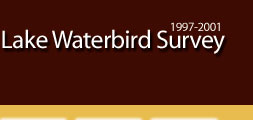 |
 |
 |
||||||||||||
 |
 |
 |
 |
 |
 |
 |
 |
|||||||
|
Preface • Introduction • Study Objectives • Community Participation • Regional, Physical and Ecological Setting Methods • Survey Protocol • Surveyors • Data Compilation • Data Analysis Results • Migration Chronology • Breeding Species • GSL Species Accounts • Species Distribution Discussion • Recommendations • Acknowledgements • Definitions/Abbreviations • Literature Cited Report & Appendices: 1 • 2 • 3 • 4 • 5 • 6 • 7 • 8 21-Year Waterbird Survey Synopsis & Appendices: 1B • 2B • 4B • 5B • 6B • 8B
|
Study ObjectivesIt became evident to those working with GSL avian resources that to more fully understand how birds distribute across the landscape and how each habitat complex contributes to occurrence and abundance of waterbirds through time, a comprehensive study was in order. In 1996, wildlife biologists and managers met on several occasions to develop plans for an ecosystem-based waterbird survey. The Great Salt Lake Ecosystem Project (GSLEP) of the Utah Division of Wildlife Resources (UDWR) managed the program. The GSLEP terrestrial Wildlife Biologist was assigned to oversee the project, but the project was founded in the community with community participants sharing ownership. Several decisions were made at the beginning to assist in narrowing the focus including setting the survey period, and limiting the target species to waterbirds of the families: Gaviidae, Podicipedidae, Pelecanidae, Phalacrocoracidae, Ardeidae, Threskiornithidae, Anatidae, Rallidae, Gruidae, Charadriidae, Recurvirostridae, Scolopacidae, Laridae. A detailed list is included as Appendix 1. Passerine marsh birds were excluded. Except for a few small sections associated with wetland surveys, uplands were excluded from the inventoried habitat types. A primary objective was established and inventory protocols were developed to address it. The primary project objective as stated in the Great Salt Lake Waterbird Survey Narrative is: The collection of data for use in conservation planning for the GSL was a secondary objective that evolved through the development of the protocol and which was of particular interest to the drafters of GSL avian plans, especially the Draft Shorebird Management Plan, and to habitat managers. The protocols developed to address these objectives will be discussed in the methods section of this report. |